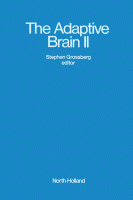Browse content
Table of contents
Actions for selected chapters
- Full text access
- Book chapterAbstract only
Chapter 1 - THE QUANTIZED GEOMETRY OF VISUAL SPACE: THE COHERENT COMPUTATION OF DEPTH, FORM, AND LIGHTNESS
Stephen Grossberg
Pages 1-79 - Book chapterAbstract only
Chapter 2 - NEURAL DYNAMICS OF FORM PERCEPTION: BOUNDARY COMPLETION, ILLUSORY FIGURES, AND NEON COLOR SPREADING
Stephen Grossberg and Ennio Mingolla
Pages 80-142 - Book chapterAbstract only
Chapter 3 - NEURAL DYNAMICS OF PERCEPTUAL GROUPING: TEXTURES, BOUNDARIES, AND EMERGENT SEGMENTATIONS
Stephen Grossberg and Ennio Mingolla
Pages 143-210 - Book chapterAbstract only
Chapter 4 - NEURAL DYNAMICS OF BRIGHTNESS PERCEPTION: FEATURES, BOUNDARIES, DIFFUSION, AND RESONANCE
Michael A. Cohen and Stephen Grossberg
Pages 211-270 - Book chapterAbstract only
Chapter 5 - ADAPTATION AND TRANSMITTER GATING IN VERTEBRATE PHOTORECEPTORS
Gail A. Carpenter and Stephen Grossberg
Pages 271-310 - Book chapterNo access
Chapter 6 - THE ADAPTIVE SELF-ORGANIZATION OF SERIAL ORDER IN BEHAVIOR: SPEECH, LANGUAGE, AND MOTOR CONTROL
Stephen Grossberg
Pages 311-400 - Book chapterAbstract only
Chapter 7 - NEURAL DYNAMICS OF WORD RECOGNITION AND RECALL: ATTENTIONAL PRIMING, LEARNING, AND RESONANCE
Stephen Grossberg and Gregory Stone
Pages 401-455 - Book chapterAbstract only
Chapter 8 - NEURAL DYNAMICS OF SPEECH AND LANGUAGE CODING: DEVELOPMENTAL PROGRAMS, PERCEPTUAL GROUPING, AND COMPETITION FOR SHORT TERM MEMORY
Michael Cohen and Stephen Grossberg
Pages 456-498 - Book chapterNo access
AUTHOR INDEX
Pages 499-504 - Book chapterNo access
SUBJECT INDEX
Pages 505-513
About the book
Description
The Adaptive Brain, II: Vision, Speech, Language, and Motor Control focuses on a unified theoretical analysis and predictions of important psychological and neurological data that illustrate the development of a true theory of mind and brain. The publication first elaborates on the quantized geometry of visual space and neural dynamics of form perception. Discussions focus on reflectance rivalry and spatial frequency detection, figure-ground separation by filling-in barriers, and disinhibitory propagation of functional scaling from boundaries to interiors. The text then takes a look at neural dynamics of perceptual grouping and brightness perception. Topics include simulation of a parametric binocular brightness study, smoothly varying luminance contours versus steps of luminance change, macrocircuit of processing stages, paradoxical percepts as probes of adaptive processes, and analysis of the Beck theory of textural segmentation. The book examines the neural dynamics of speech and language coding and word recognition and recall, including automatic activation and limited-capacity attention, a macrocircuit for the self-organization of recognition and recall, role of intra-list restructuring arid contextual associations, and temporal order information across item representations. The manuscript is a vital source of data for scientists and researchers interested in the development of a true theory of mind and brain.
The Adaptive Brain, II: Vision, Speech, Language, and Motor Control focuses on a unified theoretical analysis and predictions of important psychological and neurological data that illustrate the development of a true theory of mind and brain. The publication first elaborates on the quantized geometry of visual space and neural dynamics of form perception. Discussions focus on reflectance rivalry and spatial frequency detection, figure-ground separation by filling-in barriers, and disinhibitory propagation of functional scaling from boundaries to interiors. The text then takes a look at neural dynamics of perceptual grouping and brightness perception. Topics include simulation of a parametric binocular brightness study, smoothly varying luminance contours versus steps of luminance change, macrocircuit of processing stages, paradoxical percepts as probes of adaptive processes, and analysis of the Beck theory of textural segmentation. The book examines the neural dynamics of speech and language coding and word recognition and recall, including automatic activation and limited-capacity attention, a macrocircuit for the self-organization of recognition and recall, role of intra-list restructuring arid contextual associations, and temporal order information across item representations. The manuscript is a vital source of data for scientists and researchers interested in the development of a true theory of mind and brain.
Details
ISBN
978-0-444-70414-6
Language
English
Published
1987
Copyright
Copyright © 1987 Elsevier B.V. All rights reserved.
Imprint
North Holland
